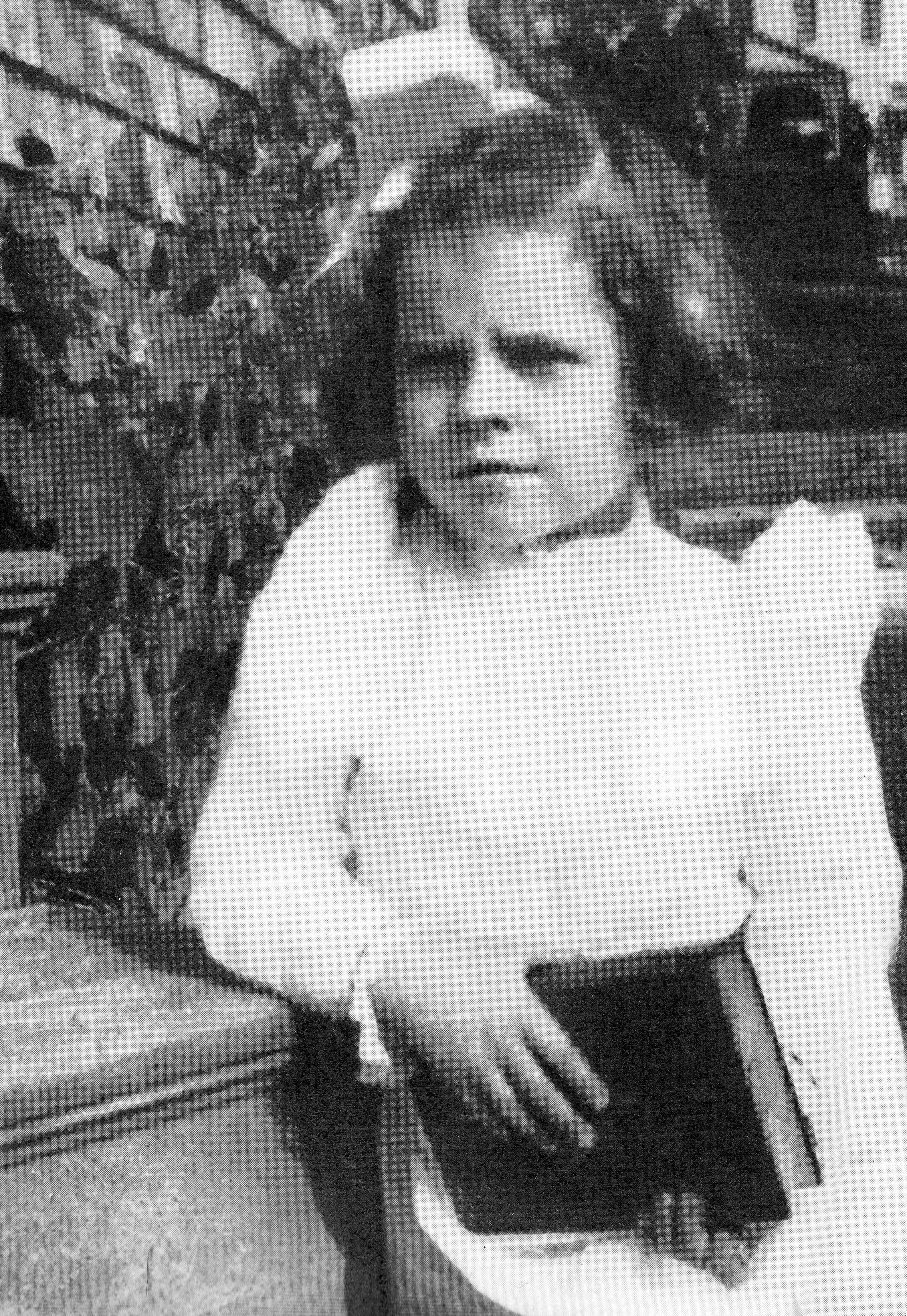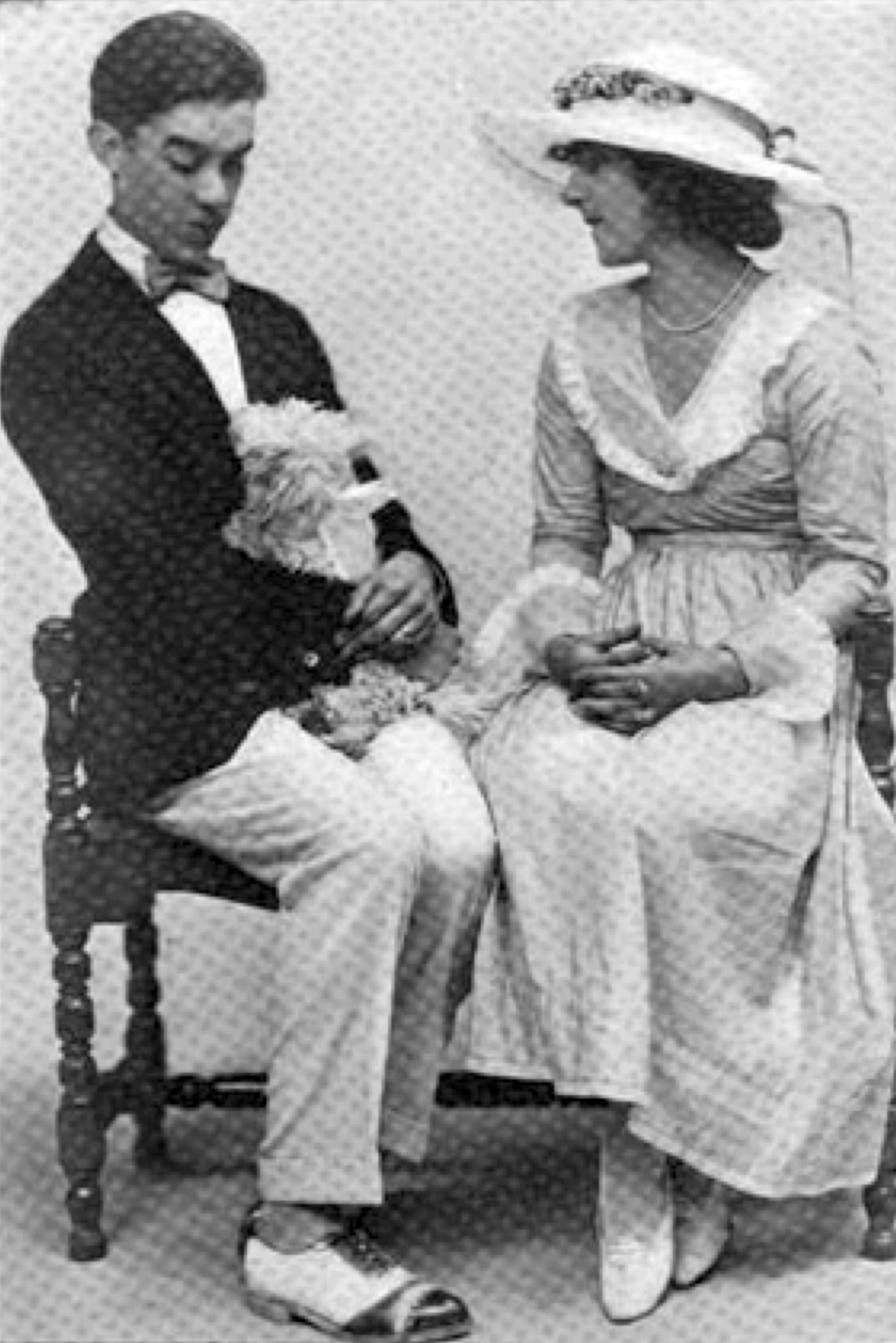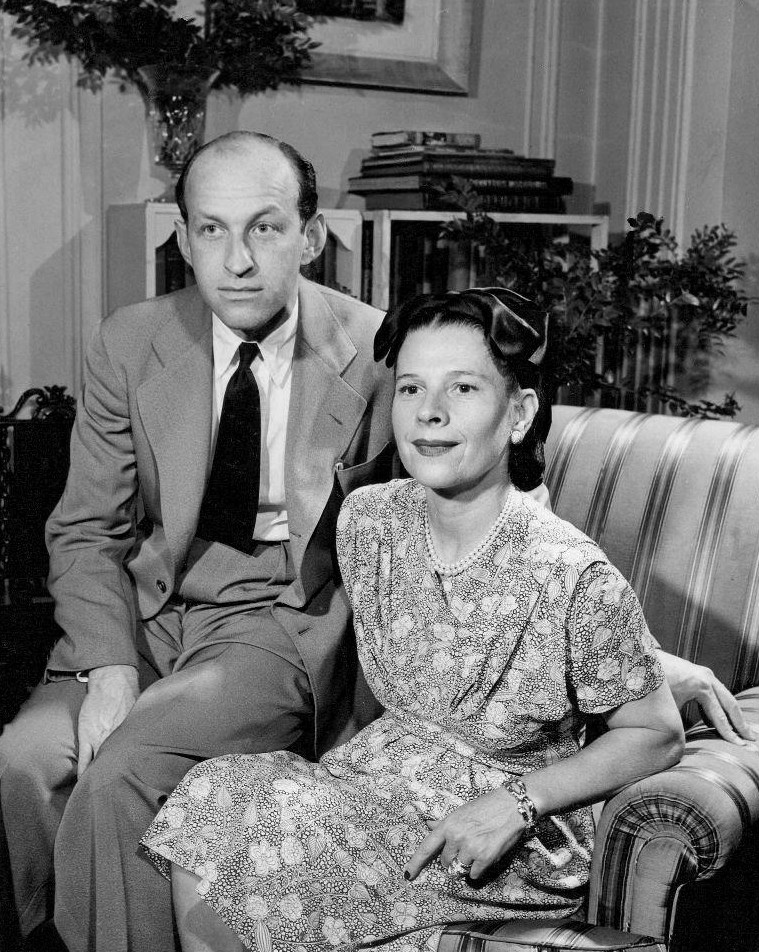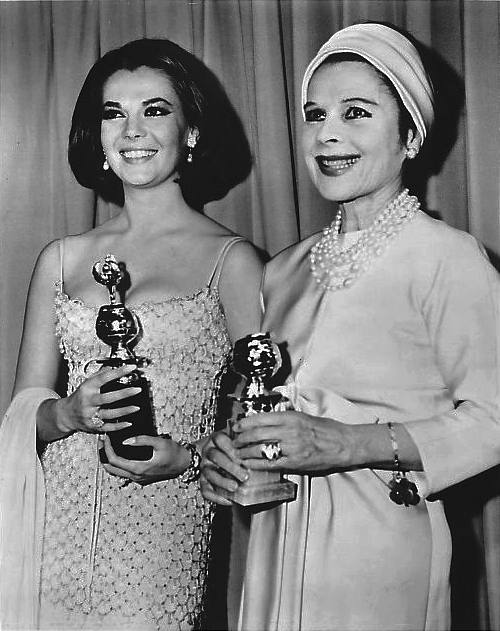1. Early life and education
1.1. Birth and family

Ruth Gordon Jones was born on October 30, 1896, in Quincy, Massachusetts, at 41 Winthrop Avenue. She later resided at 41 Marion Street from 1901 to 1903 and at 14 Elmwood Avenue from 1903 to 1914; all three homes were located in the Wollaston section of Quincy. Her parents were Annie Tapley (née Ziegler) and Clinton Jones. She had an older half-sister named Claire, from her father's first marriage. Gordon was baptized as an Episcopalian. Her first public appearance occurred as an infant when her photograph was used in advertisements for her father's employer, Mellin's Food for Infants and Invalids.
1.2. Education
Before graduating from Quincy High School, Ruth Gordon wrote to several of her favorite actresses, requesting autographed pictures. A personal reply from actress Hazel Dawn, whom Gordon had seen in a stage production of The Pink Lady, inspired her to pursue an acting career. Although her father was initially skeptical about her chances of success in such a challenging profession, he eventually took her to New York City in 1914, where he enrolled her in the American Academy of Dramatic Arts.
2. Career
Ruth Gordon's extensive professional life spanned various performance mediums, from her early stage work to her later film and television appearances, establishing her as a versatile and enduring presence in the entertainment industry.
2.1. Stage and silent film career
In 1915, Gordon began her career as an extra in silent films that were shot in Fort Lee, New Jersey, including a role as a dancer in The Whirl of Life, a film based on the lives of Vernon and Irene Castle. That same year, she made her Broadway debut at age 19 in a revival of Peter Pan, or the Boy Who Wouldn't Grow Up, playing the role of Nibs, one of the Lost Boys. She appeared onstage with Maude Adams and received a favorable mention from the influential critic Alexander Woollcott, who described her as "ever so gay" and subsequently became her friend and mentor.

In 1918, Gordon starred opposite actor Gregory Kelly in the Broadway adaptation of Booth Tarkington's novel Seventeen. The pair continued to perform together in North American tours of Frank Craven's The First Year and Tarkington's Clarence and Tweedles. In 1921, Gordon and Kelly were married. In December 1920, Gordon underwent a procedure in a Chicago hospital to have her legs broken and straightened to treat her lifelong bow-leggedness. After a three-month recovery, she moved to Indianapolis, where she and Kelly established a repertory company.
Kelly died of heart disease in 1927 at the age of 36. Gordon at the time had been enjoying a career resurgence, appearing on Broadway as Bobby in Maxwell Anderson's Saturday's Children, a serious role that marked a departure from her previous typecasting as a "beautiful, but dumb" character. In 1929, while starring in the hit play Serena Blandish, Gordon became pregnant by the show's producer, Jed Harris. Their son, Jones Harris, was born in Paris that year, and Gordon brought him back to New York City. Although Gordon and Harris never married, they provided their son with a normal upbringing, and his parentage became public knowledge as social conventions evolved. By 1932, the family was living discreetly in an elegant New York City brownstone. Their son, Jones Harris, later married actress and heiress Heidi Vanderbilt.
2.2. Film and broadcast activities (by period)
This section details Ruth Gordon's extensive career in film and television, spanning several decades and highlighting her key roles and collaborations during each period.
2.2.1. 1930s
Ruth Gordon continued to act extensively on the stage throughout the 1930s. Her notable performances included the role of Mattie in Ethan Frome, Margery Pinchwife in William Wycherley's Restoration comedy The Country Wife at London's Old Vic theatre and on Broadway, and Nora Helmer in Henrik Ibsen's classic play A Doll's House, which she performed in Central City, Colorado, and later on Broadway.
2.2.2. 1940s

Although Ruth Gordon was signed to a Metro-Goldwyn-Mayer film contract in the early 1930s, she did not make a movie for the company until her supporting role in Greta Garbo's final film, Two-Faced Woman (1941). She found more success at other Hollywood studios, appearing in a string of supporting roles in the early 1940s, including Mary Todd Lincoln in Abe Lincoln in Illinois (1940), Hedwig Ehrlich in Dr. Ehrlich's Magic Bullet (1940), and Mrs. Sarah Jarvis in Action in the North Atlantic (1943). Her Broadway acting appearances in the 1940s featured her as Iris in Paul Vincent Carroll's The Strings, My Lord, Are False, Natasha in Katharine Cornell and Guthrie McClintic's revival of Anton Chekhov's Three Sisters, and leading roles in her own plays, Over Twenty-One and The Leading Lady.
In 1942, Gordon married her second husband, the writer Garson Kanin. Together, Gordon and Kanin collaborated on the screenplays for the popular Katharine Hepburn and Spencer Tracy films Adam's Rib (1949) and Pat and Mike (1952). Both films were directed by George Cukor. Being close friends with Hepburn and Tracy, Gordon and Kanin skillfully incorporated elements of the actors' real-life personalities into the films. Their collaborative screenwriting efforts earned them Academy Award nominations for both Adam's Rib and Pat and Mike, as well as for A Double Life (1947), which was also directed by Cukor.
2.2.3. 1950s
In 1953, Gordon's autobiographical play Years Ago was adapted into the film The Actress by MGM, with Jean Simmons portraying the young girl from Quincy, Massachusetts, who persuades her sea captain father to allow her to pursue an acting career in New York. Gordon herself later authored three volumes of memoirs in the 1970s: My Side, Myself Among Others, and An Open Book.
Gordon continued her stage-acting career throughout the 1950s. She was nominated for a 1956 Tony Award for Best Performance by a Leading Actress in a Play for her acclaimed portrayal of Dolly Levi in Thornton Wilder's The Matchmaker, a role she performed in London, Edinburgh, and Berlin.
2.2.4. 1960s

The 1960s marked a significant period of international recognition for Ruth Gordon. In 1966, she received an Academy Award nomination and won a Golden Globe Award for Best Supporting Actress for her role as Lucile Clover in Inside Daisy Clover, where she starred opposite Natalie Wood. This was her first Academy Award nomination for acting.
In 1969, Gordon achieved her most significant acting accolade, winning the Academy Award for Best Supporting Actress for her performance as Minnie Castevet in Rosemary's Baby. This film, directed by Roman Polanski, was an adaptation of Ira Levin's bestselling horror novel about a satanic cult residing in a Manhattan apartment building. During her acceptance speech at the 41st Academy Awards, a 72-year-old Gordon, who had been in the business for 50 years, humorously thanked the academy, stating, "I can't tell you how encouraging a thing like this is..." and added, "And thank all of you who voted for me, and to everyone who didn't: please, excuse me," eliciting laughter and applause from the audience. She also won another Golden Globe for her role in Rosemary's Baby. In 1971, she was nominated for another Golden Globe for her portrayal of Maude in Harold and Maude, where she played an 80-year-old woman who falls in love with a much younger man, played by Bud Cort. This film was noted for its unconventional themes and generated some controversy in conservative media.
2.2.5. Later career (1970s onwards)
Ruth Gordon remained remarkably prolific in her 70s and 80s, appearing in 22 more films and numerous television productions. Her television work included roles in successful sitcoms such as Rhoda, where she played the mother of the unseen doorman Carlton, earning her an Emmy Award nomination. She also appeared in Newhart as Blanche Devane, Kirk's grandmother, across two episodes in 1983 and 1984. In 1977, she portrayed a murderous author, Abigail Mitchell, on the Columbo episode "Try and Catch Me," a role for which she received critical acclaim as the oldest culprit in the series, possibly inspired by Agatha Christie. Gordon made countless appearances on talk shows and even hosted Saturday Night Live in 1977.
In 1979, she won an Emmy Award for her appearance on the sitcom Taxi, for the episode titled "Sugar Mama," in which her character, Dee Wilcox, attempts to solicit the services of a taxi driver, played by series star Judd Hirsch, as a male escort.
Her last Broadway appearance was in 1976, playing Mrs. Warren in George Bernard Shaw's Mrs. Warren's Profession, produced by Joseph Papp at the Vivian Beaumont Theater. In the summer of 1976, Gordon starred in the leading role of her own play, Ho! Ho! Ho! at the Cape Playhouse in Dennis, Massachusetts. She also had a memorable minor role as Senovia "Ma" Boggs, the mother of Orville Boggs (Geoffrey Lewis), in the Clint Eastwood films Every Which Way but Loose (1978) and Any Which Way You Can (1980).
In 1983, Gordon was honored with the Crystal Award from Women in Film Los Angeles, recognizing her outstanding contributions and endurance in expanding the role of women within the entertainment industry. Three of her most iconic works, Harold and Maude, Adam's Rib, and Rosemary's Baby, have been selected for preservation in the National Film Registry of the United States Library of Congress, underscoring their cultural and historical significance.
3. Writing career
Ruth Gordon's contributions as a writer extended to screenplays, plays, and memoirs, showcasing her diverse creative talents.
3.1. Screenplays
Ruth Gordon's significant contributions as a screenwriter were primarily in collaboration with her second husband, Garson Kanin. Together, they penned the screenplays for several notable films. Their most acclaimed works include A Double Life (1947), and the Katharine Hepburn and Spencer Tracy vehicles Adam's Rib (1949) and Pat and Mike (1952). All three films were directed by George Cukor. The screenplays for A Double Life, Adam's Rib, and Pat and Mike earned Gordon and Kanin a total of three Academy Award nominations for Best Original Screenplay. Gordon also contributed to the screenplay for The Actress (1953), which was an adaptation of her own autobiographical play.
3.2. Plays and memoirs
As a playwright, Ruth Gordon wrote several original works. Her autobiographical play, Years Ago, was later adapted into the 1953 film The Actress. Other plays she authored include Over Twenty-One, The Leading Lady, and Ho! Ho! Ho!.
In the 1970s, Gordon also published three volumes of memoirs, offering personal reflections and insights into her life and career. These autobiographical works are titled My Side, Myself Among Others, and An Open Book.
4. Personal life
This section explores Ruth Gordon's personal relationships, focusing on her marriages and the birth of her son.
4.1. Marriage and children
Ruth Gordon married her first husband, actor Gregory Kelly, in 1921. Their collaboration extended beyond their marriage, as they frequently performed together in various stage productions. Kelly tragically died of heart disease in 1927 at the age of 36.
In 1929, Gordon gave birth to her son, Jones Harris, in Paris. His father was Jed Harris, the producer of the play Serena Blandish, in which Gordon was starring at the time. Although Gordon and Jed Harris never married, they ensured their son had a normal upbringing. Jones Harris later married actress and heiress Heidi Vanderbilt.
In 1942, Gordon married her second husband, the renowned writer Garson Kanin. Their marriage lasted for 43 years until her death in 1985. Kanin was by her side when she passed away, noting that even her final day was full of activity, including walks, conversations, errands, and a morning spent working on a new play.
5. Awards and nominations
| Year | Award | Category | Work | Result |
|---|---|---|---|---|
| 1947 | Academy Awards | Best Original Screenplay | A Double Life | Nominated |
| 1950 | Adam's Rib | Nominated | ||
| 1952 | Pat and Mike | Nominated | ||
| 1965 | Best Supporting Actress | Inside Daisy Clover | Nominated | |
| 1968 | Rosemary's Baby | Won | ||
| 1965 | Golden Globe Awards | Best Supporting Actress - Motion Picture | Inside Daisy Clover | Won |
| 1968 | Rosemary's Baby | Won | ||
| 1971 | Best Actress in a Motion Picture - Musical or Comedy | Harold & Maude | Nominated | |
| 1976 | Primetime Emmy Awards | Outstanding Single Performance by a Supporting Actress in a Comedy or Drama Series | Rhoda | Nominated |
| 1977 | Outstanding Performance by a Supporting Actress in a Comedy or Drama Special | The Great Houdini | Nominated | |
| 1979 | Outstanding Lead Actress in a Comedy Series | Taxi | Won | |
| 1985 | Outstanding Individual Achievement - Informational Programming - Performing | The Secret World of the Very Young | Nominated | |
| 1956 | Tony Awards | Best Leading Actress in a Play | The Matchmaker | Nominated |
| 1949 | Writers Guild of America Awards | Best Written Comedy | Adam's Rib | Nominated |
| 1950 | Adam's Rib | Nominated | ||
| 1952 | Pat and Mike | Nominated | ||
| 1952 | The Marrying Kind | Nominated | ||
| 1953 | The Actress | Nominated |
In 1983, Gordon was awarded the Women in Film Crystal Award for outstanding women who, through their endurance and the excellence of their work, have helped to expand the role of women within the entertainment industry.
6. Assessment and legacy
This section examines Ruth Gordon's lasting impact on the arts and American culture, recognizing her diverse talents and the societal influence of her work.
6.1. Artistic contributions
Ruth Gordon's artistic contributions spanned over seven decades, showcasing her versatility as an actress, playwright, and screenwriter. She became particularly renowned for her distinctive nasal voice and unique personality, which she skillfully leveraged in her performances. In her later career, she cultivated a beloved persona playing small, sharp-witted elderly women, a character type that became her signature and endeared her to a wide audience. Her ability to transition seamlessly between dramatic, comedic, and even unsettling roles, as seen in Rosemary's Baby and Harold and Maude, highlights her exceptional range and enduring appeal.
6.2. Social and cultural impact
Gordon's work left a significant mark on American culture. Her roles, particularly in films like Harold and Maude, challenged conventional perceptions of age, romance, and societal norms. While Harold and Maude sparked some controversy in conservative media due to its themes, it has since become a cult classic, celebrated for its unique perspective and enduring message. The selection of Harold and Maude, Adam's Rib, and Rosemary's Baby for preservation in the National Film Registry of the United States Library of Congress underscores their lasting cultural and historical significance. Furthermore, her recognition with the Crystal Award from Women in Film Los Angeles in 1983 acknowledges her pioneering role and endurance in expanding opportunities and perceptions for women within the entertainment industry.
7. Death
Ruth Gordon died on August 28, 1985, at the age of 88, at her summer home in Edgartown, Massachusetts. Her death was caused by a stroke. Her husband of 43 years, Garson Kanin, was by her side. Kanin noted that even on her last day, Gordon's life was typically full, encompassing walks, conversations, errands, and a morning spent working on a new play. She had made her final public appearance just two weeks prior at a benefit screening of the film Harold and Maude and had recently completed acting in four films, demonstrating her enduring dedication to her craft until the very end.
8. Memorials and honors
In August 1979, a small movie theater in Westborough, Massachusetts, was named the Ruth Gordon Flick in her honor. Gordon attended the opening ceremony, standing on a bench in the lobby to be seen by attendees. The theater no longer exists. In November 1984, the outdoor amphitheater in Merrymount Park in her hometown of Quincy, Massachusetts, was also named the Ruth Gordon Amphitheater, serving as a lasting tribute to her legacy.
9. Works
This section provides a comprehensive listing of Ruth Gordon's professional works across film, television, and theatre, including her acting and writing credits.
9.1. Filmography
| Year | Title | Role | Notes |
|---|---|---|---|
| 1915 | The Whirl of Life | Extra | Uncredited |
| Madame Butterfly | Minor Role | Uncredited | |
| Camille | Party Guest | Uncredited | |
| 1940 | Abe Lincoln in Illinois | Mary Todd Lincoln | |
| Dr. Ehrlich's Magic Bullet | Hedwig Ehrlich | ||
| 1941 | Two-Faced Woman | Miss Ruth Ellis, Larry's Secretary | |
| 1943 | Edge of Darkness | Anna Stensgard | |
| Action in the North Atlantic | Mrs. Sarah Jarvis | ||
| 1965 | Inside Daisy Clover | Lucile Clover | |
| 1966 | Lord Love a Duck | Stella Bernard | |
| 1968 | Rosemary's Baby | Minnie Castevet | |
| 1969 | What Ever Happened to Aunt Alice? | Alice Dimmock | |
| 1970 | Where's Poppa? | Mrs. Hocheiser | |
| 1971 | Harold and Maude | Maude | |
| 1976 | The Big Bus | Old Woman | |
| 1978 | Every Which Way but Loose | Senovia "Ma" Boggs | |
| 1979 | Boardwalk | Becky Rosen | |
| Scavenger Hunt | Arvilla Droll | ||
| 1980 | My Bodyguard | Gramma Peache | |
| Any Which Way You Can | Senovia "Ma" Boggs | ||
| 1982 | Jimmy the Kid | Bernice | |
| 1985 | Delta Pi | Mugsy | |
| Voyage of the Rock Aliens | Sheriff | Filmed in 1983 | |
| Maxie | Mrs. Lavin | ||
| 1987 | The Trouble with Spies | Mrs. Arkwright | Filmed in 1984; Final film role |
9.2. Television
| Year | Title | Role | Notes |
|---|---|---|---|
| 1950 | Prudential Family Playhouse | Paula Wharton | Episode: "Over 21" |
| 1966 | Blithe Spirit | Madame Arcati | Television movie |
| 1973 | Isn't It Shocking? | Marge Savage | Television movie |
| 1975 | Kojak | Miss Eudora Temple | Episode: "I Want to Report a Dream" |
| Rhoda | Carlton's Mother | Episode: "Kiss Your Epaulets Goodbye" | |
| Medical Story | Emily Dobson | Episode: "The Right to Die" | |
| 1976 | The Great Houdini | Cecilia Weiss | Television movie |
| Look What's Happened to Rosemary's Baby | Minnie Castevet | Television movie | |
| Emergency! | Lenore | Episode: "The Nuisance" | |
| 1977 | Columbo | Abigail Mitchell | Episode: "Try and Catch Me" |
| Saturday Night Live | Host | Episode: "Ruth Gordon/Chuck Berry" | |
| The Love Boat | Mrs. Warner | Episode: "Joker Is Mild, The/First Time Out/Take My Granddaughter, Please" | |
| The Prince of Central Park | Mrs. Miller | Television movie | |
| 1978 | Perfect Gentlemen | Mrs. Cavagnaro | Television movie |
| 1979 | Taxi | Dee Wilcox | Episode: "Sugar Mama" |
| 1980 | Hardhat and Legs | Grandmother | Uncredited; also writer |
| 1982 | Don't Go to Sleep | Bernice | Television movie |
| 1983 | Newhart | Blanche Devane | Episode: "Grandma, What a Big Mouth You Have" |
| 1984 | Newhart | Blanche Devane | Episode: "Go, Grandma, Go" |
9.3. Theatre
| Year | Title | Role | Notes |
|---|---|---|---|
| 1916 | Peter Pan | Nibs | Revival |
| 1917 | Seventeen | Lola Pratt | |
| 1923 | Tweedles | Winsora | |
| 1925 | Mrs. Partridge Presents | Katherine Everitt | |
| 1925 | The Fall of Eve | Eva Hutton | |
| 1928 | Saturday's Children | Bobby | |
| 1929 | Serena Blandish | Serena Blandish | |
| 1929 | Lady Fingers | Ruth | Also in ensemble |
| 1930 | Hotel Universe | Lily Malone | |
| 1930 | The Violet and One, Two, Three | Ilona Stobri | The Violet |
| 1931 | The Wiser They Are | Trixie Ingram | |
| 1932 | A Church Mouse | Susie Sachs | |
| 1932 | Here Today | Mary Hilliard | |
| 1933 | Three-Cornered Moon | Elizabeth Rimplegar | |
| 1934 | They Shall Not Die | Lucy Wells | |
| 1934 | A Sleeping Clergyman | Harriet Marshall | |
| 1936 | Ethan Frome | Mattie Silver | |
| 1937 | The Country Wife | Mrs. Margery Pinchwife | |
| 1938 | A Doll's House | Nora Helmer | |
| 1942 | The Strings, My Lord, Are False | Iris Ryan | |
| 1943 | The Three Sisters | Natalya Ivanovna | |
| 1944 | Over 21 | Paula Wharton | Also writer |
| 1947 | Years Ago | Also writer | |
| 1947 | How I Wonder | Also producer | |
| 1948 | The Leading Lady | Also writer | |
| 1949 | The Smile of the World | Sara Boulting | |
| 1957 | The Matchmaker | Mrs. Dolly Gallagher Levi | |
| 1960 | The Good Soup | Marie-Paule I | |
| 1963 | My Mother, My Father and Me | Rona Halpern | |
| 1965 | A Very Rich Woman | Mrs. Lord | Also writer |
| 1966 | The Loves of Cass McGuire | Cass | |
| 1974 | Dreyfus in Rehearsal | Zina | |
| 1976 | Mrs. Warren's Profession | Mrs. Kitty Warren |
9.4. Writing credits
| Year | Title | Notes |
|---|---|---|
| 1944 | Over 21 | |
| 1946 | Years Ago | |
| 1947 | A Double Life | |
| 1948 | The Leading Lady | |
| 1948 | The Ford Theatre Hour | Episode: Years Ago |
| 1949 | Adam's Rib | |
| 1950 | Prudential Family Playhouse | Episode: Over 21 |
| 1952 | Pat and Mike | |
| The Marrying Kind | ||
| 1953 | The Actress | |
| 1957 | The Alcoa Hour | Episode: "A Double Life" |
| 1960 | DuPont Show of the Month | Episode: "Years Ago" |
| 1967 | Rosie! | |
| 1973 | Adam's Rib | Episode: "The Unwritten Law" |
| 1976 | Ho! Ho! Ho! | |
| 1980 | Hardhat and Legs |